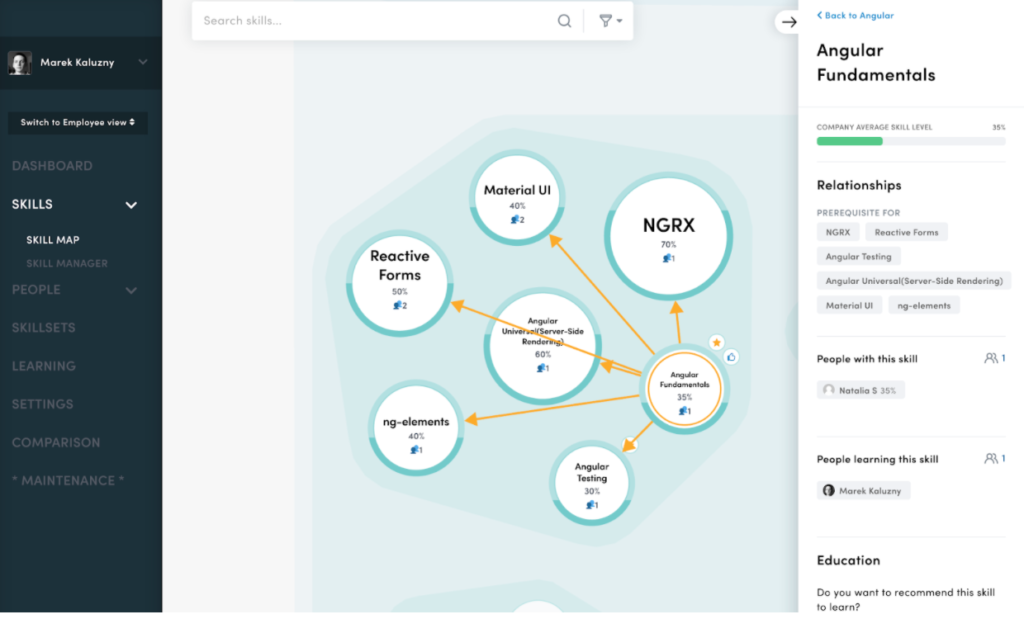
What is competency mapping and why you need it in your company

Many organizations with a modern, agile approach to work, are employing competency analysis to gather information on the proficiency of employees and focus on a skills-based approach to work.
The hiring process in technical recruitment is difficult. It is often hard to find the right candidates and it has become far easier to improve the skills of those already within an organization and reskill them into a new job role if need be. To do this effectively, the hard skills and soft skills of each individual need to be mapped, as well as the key competencies of each role. Competency mapping is an evaluation of the ability and expertise of everyone within your company, to then create specific development paths for each employee. Such a move, will likely ultimately result in improved performance across the board.
Competency mapping provides organizations with an opportunity to keep an accurate track of employee progression, through a comprehensive series of logical steps. Let’s find out more.
What is competency mapping?
Competency mapping is a strategy based on the evaluation of the competencies of employees in an organization. It can be easily used to define the criteria of each job role and set a level at which employees should be able to perform. Ongoing evaluation of the proficiency levels of current employees will provide accurate and specific data on how to improve your business.
Competency mapping has a number of benefits for both the individual and the organization. First of all, it allows employees to understand their own proficiency levels and how they can improve. This, in turn, can improve employee satisfaction and bring about enhanced employee performance.
From the perspective of the employer, what makes competency mapping important, is that it increases your awareness of existing skill sets as well as identifying skill gaps within your organization. This helps you make informed decisions when it comes to:
- defining the scope of work for existing roles and new job openings
- training of your existing employees
- recruiting people with the right skill sets
As it’s becoming increasingly hard to hire tech talent, recruiters are constantly trying out new ways of making the grass seem greener on their side. It’s common knowledge that HR departments constantly work to outdo themselves by introducing new perks and benefits that come with a job role. However, once you get a good understanding of competency mapping, you can cater to the needs and interests of developers a lot more efficiently.
Assess observable and measurable knowledge with competency mapping?

Why do businesses present senior developers with stale career paths where they can only become managers, architects, or analysts? Should they really be offered one of these not-so-loved and socially unappreciated roles if their passion is coding? It’s common for burnt-out employees to ask to be migrated horizontally, be it to a different team or to a completely new role. In most cases, however, such requests are turned down because they need to stick to their current roles. Thanks to career maps, employees have an understanding of their growth opportunities and they know exactly what professional development efforts they should be making to arrive at their desired end result.
It is foolish to think that your developers are limited to the options that you give them. If you can’t give them the career they want, one of your competitors might. It is a waste of time, money, and talent to let a good developer leave your company because you haven’t supported their success.
Career trees provide a skill-based recruitment plan. Just like other competencies, technical skills are built on prerequisite skills which can be conveniently organized into a form resembling technology trees. After all, to develop front-end apps using Angular, you need to master JavaScript first. To use JavaScript efficiently to implement browser apps, you need to understand what dependencies there are between JavaScript and CSS, HTML, Web API. There are many examples of advanced skills being dependent on foundational skills. This is nothing new but various organizations typically adopt different approaches to some advanced technologies based on their context and structure.
Download our free skills management Ebook
Mapping the competencies required
The competency mapping process brings with it several advantages. Creating competency maps is a way to plan out the capabilities of every area of your business.
Once you create a career tree tailored to the specifics of your organization, you can give uniform advice on how your developers can build their skill sets. A side effect of this result is that a job description like, “frontend developer,” may become organization-specific. This means that in different organizations, that developer will possess a different skill set. While in some companies, their skills will be focused on JavaScript, in others they will likely be centered on creating graphical user interfaces and using HTML/CSS effectively. This discrepancy creates communication gaps which can luckily be eliminated quite easily. Focusing on particular skills instead of skill groups can really make a huge difference here.
Competency mapping to plug skills gaps
Detailed competency analysis is the work model of the future. Embracing a skills-based work model allows businesses to easily identify talented employees and know who to place into a particular role, depending on the task at hand. Furthermore, both existing and new employees will be provided with a clear development strategy, where they know exactly what is required to progress.
Competency mapping is an ideal way to identify skill gaps in your workforce and take steps to fill them. Functional competencies can be tracked to improve proficiency levels and used to identify those areas of your business that still require attention. Competency analysis allows your organization to map out the functional skills of your workforce and identify skills that are still needed. A particular skill that is missing can be easily learned. Quickly, this will improve the abilities of your whole team, and improve employee morale, by giving long-term employees a new focus and sense of purpose within their work.
Here is a skills map we made for Java using our competency mapping tool – TalentBoost.
Enriching your career trees with an employee’s details can show you what competencies they have and what they can easily acquire if needed. This serves as a cue for your internal developers (especially juniors) as to how they can grow professionally and to what end. Moreover, companies can support their developers in acquiring certain skills that will be needed in the organization, e.g. for future projects.
Another way to make your competency mapping more efficient is to place your recruitment candidates on your career tree. This shows you how they fit your team and simultaneously fosters skill diversification. After all, hiring people with the right skill set who can also bring a breath of fresh air to your company is a double win.
This approach means you can move away from unhelpful labels and instead make positions skill-focused. As an example, a senior developer is someone who can do at least three things on a senior level, as well as mentor less experienced colleagues. This brings up an important question: does knowing something automatically make you capable of teaching it? What about soft skills? Is one career tree sufficient to describe a person? Turns out, it isn’t.
Senior developers aren’t just coding wizards. On top of mastering tech skills, you also need to learn to communicate, work as a part of a team, share your knowledge with your community, and so forth. All these skills need to be organized in a separate career tree that runs parallel to your tech skill tree. As a consequence, a senior developer is someone who not only has the tech skill set required of the position, but who also knows the principles of building agile software, has leadership skills, and is able to speak publicly (e.g. to run a demo for a client).
Every leaf of the career tree can be labeled not only with the technology required, but also supplemented with a list of books, articles, and presentations which help master the skill in question. Storing all this information in one place allows you to learn what is required as well as how to get there.
Ready to plant career trees?
Technology is a living thing. New languages, libraries, and tools are constantly being created. Updating your career tree with these trends brings it to life. It grows and develops, just like a real tree would. Some branches get stronger, others remain weaker either losing their usefulness or being cut down. As long as you’re mindful of the changing landscape, you won’t be surprised by the way tech is evolving.
The final question to ask at this point is this: what happens when career paths in your organization are unregulated? That’s even better. As you’re implementing career trees, you can go ahead and implement them in an optimized and innovative way. The benefit for you is that once you get a full understanding of competency mapping meaning and benefits, you’ll be able to help them reach their full potential.
Introducing TalentBoost
Want to find out more about our competency mapping tool – DevSkiller TalentBoost
For more recruiting tools, check out 17 recruiting tools every recruiter should use in their recruitment process





